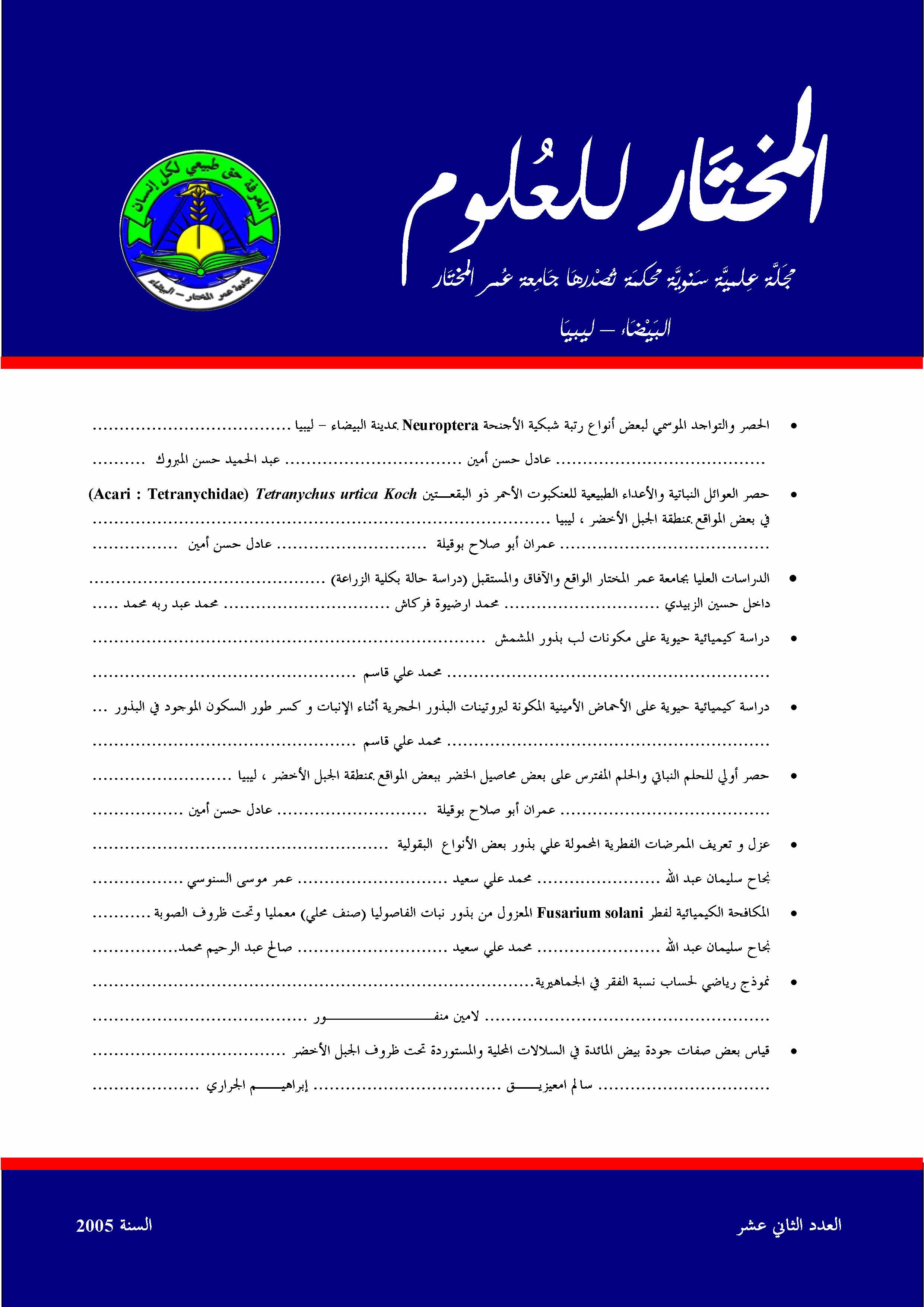Biochemical study on the constituents of apricot seed kernels
DOI:
https://doi.org/10.54172/mjsc.v12i1.541Keywords:
Biochemical , study , apricot seed kernelsAbstract
The main Objectives of this study are: (1) Investigated that the major chemical composition of the apricot kernels to show to what such wastes might be used in edible consumptions, (2) Isolation, characterization and evaluation of its proteins. We found that apricot kernels contained higher level of protein (26.3 %). The essential amino acids comprise (34.3%) of the total amino acids, isoleucine was the most predominant one followed by valine. The chemical scores of essential amino acids and protein efficiency ratio (PER) were also determined. The Distribution of extracted protein showed a wide range of variation among the fractions, the albumins represent the highest proportion of the extracted proteins followed by globulins, prolamins and glutelins. The solubility at alkaline pH, up to 9 was higher than that recorded at neutral pH, the minimum solubilities of the proteins concentrates were between pH 4 and 5 which indicate the proximity of these pH values to the isolelectric point, where most of the amino acids could exist in the Zwitter ionic form.
The other constituents are carbohydrate (13.9%), crude fiber (2.5 %), ash (3%) and crude oil (48%). Determination of minerals indicated that there are higher level of K, Ca, Na, Mg, Fe, Mn, Zn and Cu in apricot kernel samples.
Downloads
References
Abd El-Aal, M.H.A.; Hamza, M.A. and Rahma, E.H. (1986): In vitro digestibility, physicochemical and functional properties of apricot kernel proteins. Food Chem., 19:197-211.
Abd El-Samei, M.B.; Khalil, M.K.M.; Rahma, E.H. (1986); Apricot kernel oil: characterization, chemical composition and utilization is some backed products. Food Chem., 19:287-298.
AOAC Official Methods of Analytical, Association of Official Analytical Chemists, Washington, DC, 1980, pp. 506-510.
Azab, M.S. and Pterson, P.J. (1989): The removal of cadium from water by the use of biological sorbents. Water Sci. Technol., 21: 1705-1706.
Blauth, O.J.; Charezinski, M. and Berbec, H. (1963): A new rapid method for determining tryptophan. Anal. Biochem., 6, 29.
Conner, M., Krell, T. And Lindsay, J. G. (1996) : Planta 200, 195-202.
El-Shafei, M.A.; Abd El-Samei, M.A. and Lasztity, R. (1986) mango waste stone kernels as a new non-conventional protein source. Minia J. Agric. Res&Dev., 8: 429-435.
FAO/WHO (1973): energy and protein requirements. WHO Tech. Report No. 552; FAO Nutr. Meeting. Report Serv., 52, FAO/WHO, Geneva, Switzerland.
Gornall, A.G.; Bardawill, C.T. and David, M.M. (1949): Determination of serum protein by means of the biuret reaction. J. Biol. Chem., 177: 751-766.
Hardin, G. (1993): Living within limits: Ecology, economics and population taboos. Oxford Univ. Press, Oxford, England.
Hassan, M.Sh (1991): Evaluation of apricot kernel as a new protein source. Minia J. Agric. Res. Dev., 13: 1472-1483.
Jansch, L., Kruft, V., Schmitz, U. K. And Braun, H.P. (1996): Planta J. 9, 357-368.
Jordan, S. W. And Cronan, Jr. J. E. (1997): J. Biol. Chem. 272, 17903-17906.
Jung, R., Scott, M. P. Nam, Y. –W., Bemaan, T. W., Bassuner, R., Saalbach, L., Muntz, K. And Nietsen, N. C. (1998): Plant Cell 10, 343-357.
Lasztity, R.; Abd El-Samei, M.B. and El-Shafei, M.A. (1986): biochemical studies on some non-conventional source of protein, tomato seeds, peels and molasses. Die Nahrung, 30: 615-620.
Loening, U.E. (1967): Fractionation of high molecular weight ribonucleic acid by poly acrylamide gel electrophoresis. Biochem. J., 102: 251-257.
Morsi, K.S.; El-Wakeil, F. A. and Hallabo, S.A. (1975): Biological evaluation of apricot kernel cake. Egypt. J. Food Sci., No. 1-2, 7-15.
Mutlu, A., Chen, X., Reddy, S. And Gal, S. (1999) : Seed Sci. Res. 9, 75-84.
Sen, A. (1993): The economics of life and death. Sci. Am., 40-47.
Stavrakellis, P. (1988): Plastic composites fruit kernels or shells and/or marble chips. Patent: European patent Application 87/600009, pp.5.
Zello, G. A.; Telch, J.; Clarke, R.; Ball, R.O.; Pencharz, P.B. (1992): Reexamination of protein requirements in adult male humans by endproduct measurements of leucine and lysine metabolism. J. Nutr., 122: 1000-1008.
Downloads
Published
How to Cite
License

This work is licensed under a Creative Commons Attribution-NonCommercial 4.0 International License.
Copyright of the articles Published by Almukhtar Journal of Science (MJSc) is retained by the author(s), who grant MJSc a license to publish the article. Authors also grant any third party the right to use the article freely as long as its integrity is maintained and its original authors and cite MJSc as original publisher. Also they accept the article remains published by MJSc website (except in occasion of a retraction of the article).










